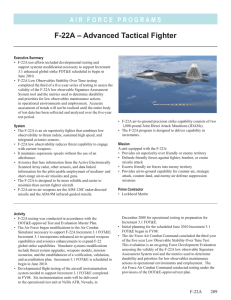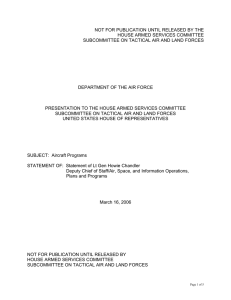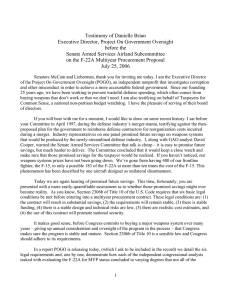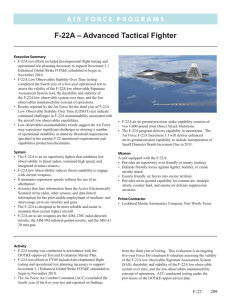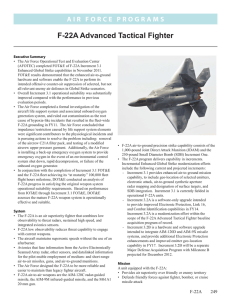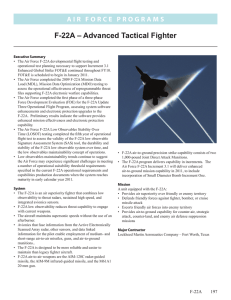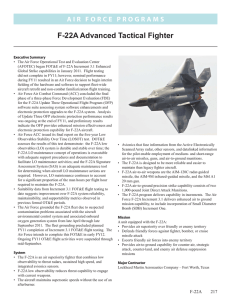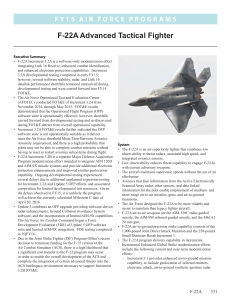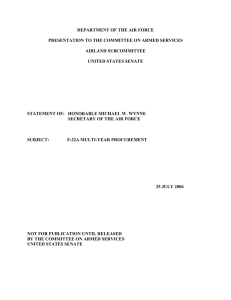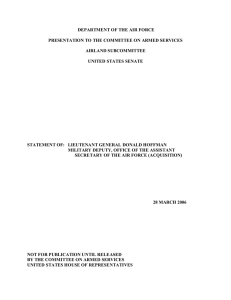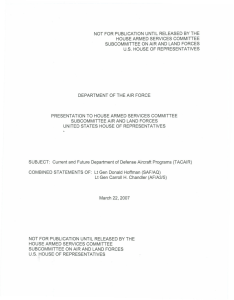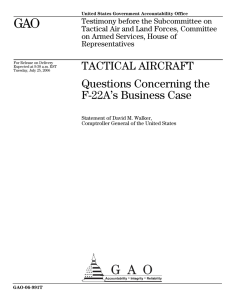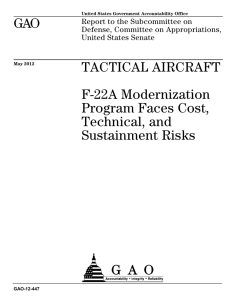F-22A – Advanced Tactical Fighter
advertisement
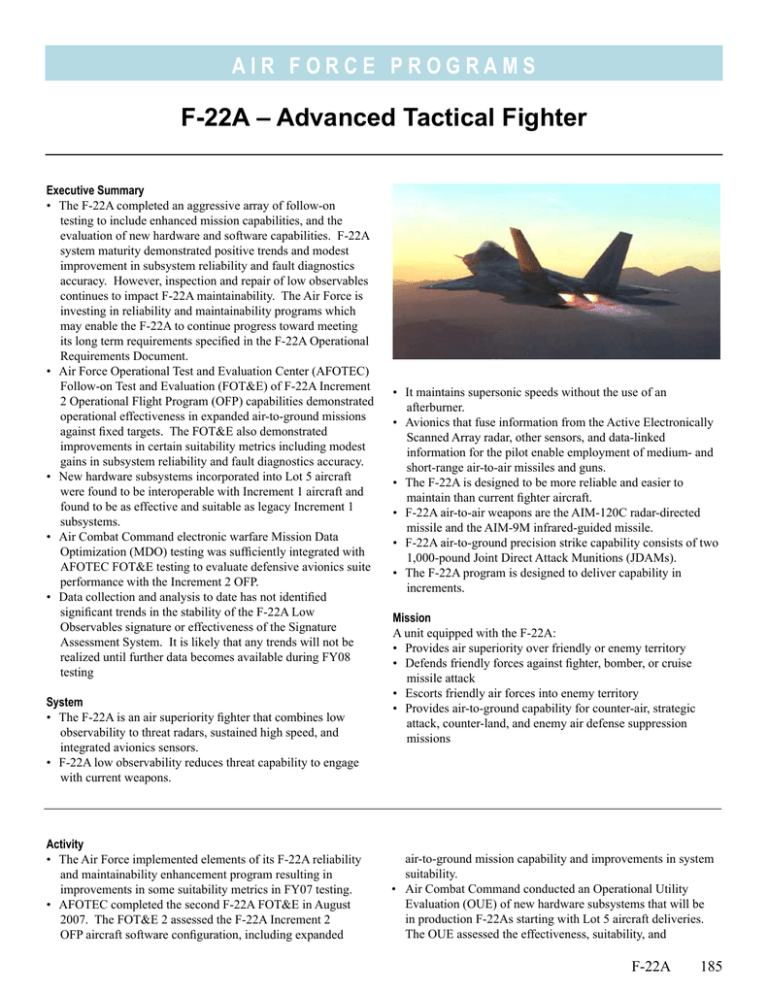
A i r F o r c e P RO G R A M S F-22A – Advanced Tactical Fighter Executive Summary • The F-22A completed an aggressive array of follow-on testing to include enhanced mission capabilities, and the evaluation of new hardware and software capabilities. F-22A system maturity demonstrated positive trends and modest improvement in subsystem reliability and fault diagnostics accuracy. However, inspection and repair of low observables continues to impact F-22A maintainability. The Air Force is investing in reliability and maintainability programs which may enable the F-22A to continue progress toward meeting its long term requirements specified in the F-22A Operational Requirements Document. • Air Force Operational Test and Evaluation Center (AFOTEC) Follow-on Test and Evaluation (FOT&E) of F-22A Increment 2 Operational Flight Program (OFP) capabilities demonstrated operational effectiveness in expanded air-to-ground missions against fixed targets. The FOT&E also demonstrated improvements in certain suitability metrics including modest gains in subsystem reliability and fault diagnostics accuracy. • New hardware subsystems incorporated into Lot 5 aircraft were found to be interoperable with Increment 1 aircraft and found to be as effective and suitable as legacy Increment 1 subsystems. • Air Combat Command electronic warfare Mission Data Optimization (MDO) testing was sufficiently integrated with AFOTEC FOT&E testing to evaluate defensive avionics suite performance with the Increment 2 OFP. • Data collection and analysis to date has not identified significant trends in the stability of the F-22A Low Observables signature or effectiveness of the Signature Assessment System. It is likely that any trends will not be realized until further data becomes available during FY08 testing System • The F-22A is an air superiority fighter that combines low observability to threat radars, sustained high speed, and integrated avionics sensors. • F-22A low observability reduces threat capability to engage with current weapons. Activity • The Air Force implemented elements of its F-22A reliability and maintainability enhancement program resulting in improvements in some suitability metrics in FY07 testing. • AFOTEC completed the second F-22A FOT&E in August 2007. The FOT&E 2 assessed the F-22A Increment 2 OFP aircraft software configuration, including expanded • It maintains supersonic speeds without the use of an afterburner. • Avionics that fuse information from the Active Electronically Scanned Array radar, other sensors, and data-linked information for the pilot enable employment of medium- and short-range air-to-air missiles and guns. • The F-22A is designed to be more reliable and easier to maintain than current fighter aircraft. • F-22A air-to-air weapons are the AIM-120C radar-directed missile and the AIM-9M infrared-guided missile. • F-22A air-to-ground precision strike capability consists of two 1,000-pound Joint Direct Attack Munitions (JDAMs). • The F-22A program is designed to deliver capability in increments. Mission A unit equipped with the F-22A: • Provides air superiority over friendly or enemy territory • Defends friendly forces against fighter, bomber, or cruise missile attack • Escorts friendly air forces into enemy territory • Provides air-to-ground capability for counter-air, strategic attack, counter-land, and enemy air defense suppression missions air-to-ground mission capability and improvements in system suitability. • Air Combat Command conducted an Operational Utility Evaluation (OUE) of new hardware subsystems that will be in production F-22As starting with Lot 5 aircraft deliveries. The OUE assessed the effectiveness, suitability, and F-22A 185 A i r F o r c e P RO G R A M S interoperability of Lot 5 hardware with the currently fielded F-22 fleet. The Lot 5 hardware, which includes the F-22A fourth generation radar, digital electronic warfare suite, intra-flight data link, communications/navigation/identification system, and several diminishing manufacturing source replacement components, provides the foundation for future F-22A increments, beginning with Increment 3 in 2010. • Air Combat Command continued electronic warfare MDO software development and testing throughout FY07. Upgrades to F-22A electronic warfare mission data software sets were released to the field in support of specific F-22A global mission tasking. Testing under the currently DOT&E‑approved MDO Test Plan will be ongoing throughout FY08. • Air Combat Command completed the second year of the F‑22A Low Observables Stability Over Time test. This five‑year test is designed to assess the durability and stability of the F-22A radar cross section, and to validate the F-22A Signature Assessment System, which is used at the flight line to ensure that aircraft have a sufficiently low signature for operational missions. Assessment • FOT&E results demonstrated that F-22As configured with the Increment 2 OFP are operationally effective in the suppression and destruction of fixed enemy air defenses. Some of the outstanding system deficiencies and weapons integration problems that were significant detractors in previous testing were resolved, enabling Increment 2 OFP-configured F-22As to achieve success in this high threat mission area. F-22As executed increasingly complex missions in high threat environments. FOT&E testing increased the understanding of the capabilities needed for sustained operational use in air-to-air and air-to-ground roles. • Air Combat Command testing determined Lot 5 hardware was interoperable with Increment 1 aircraft, and the new hardware subsystems exhibited the same level of effectiveness and suitability as the legacy Increment 1 aircraft configuration. 186 F-22A • Air Combat Command electronic warfare MDO testing was sufficiently integrated with AFOTEC FOT&E testing to evaluate defensive avionics suite performance with the Increment 2 OFP. • Data collection and analysis to date has not identified significant trends in the stability of the F-22A Low Observables signature or effectiveness of the Signature Assessment System. It is likely that any trends will not be realized until further data becomes available from FY08 testing. • Overall F-22A system maturity exhibited some positive trends and modest improvement in subsystem reliability and fault diagnostics accuracy. However, inspection and repair of low observables continues to impact F-22A maintainability. Test results demonstrated that maintaining the low-observable signature continues to require a significant effort and accounted for half of the overall maintenance man-hours expended in FOT&E 2. Additionally, restoration of the low‑observable signature requires long durations to cure materials often resulting in extended periods of time during which aircraft are not available for operational missions. • Though maintainability challenges continue to exist, reliability gains suggest incremental improvements in overall system suitability. FY07 test results suggest the Air Force’s reliability enhancement program has had a positive effect. Evaluation of F-22A reliability and maintainability improvements in follow‑on testing will be necessary to assess and confirm suitability as the F-22A progresses towards system maturity. Recommendations • Status of Previous Recommendations. There are no outstanding recommendations from previous annual reports. • FY07 Recommendation. 1. The Air Force should continue to invest resources in reliability and maintainability improvement programs to provide the opportunity for the F-22A to meet the user’s suitability requirements at system maturity.
